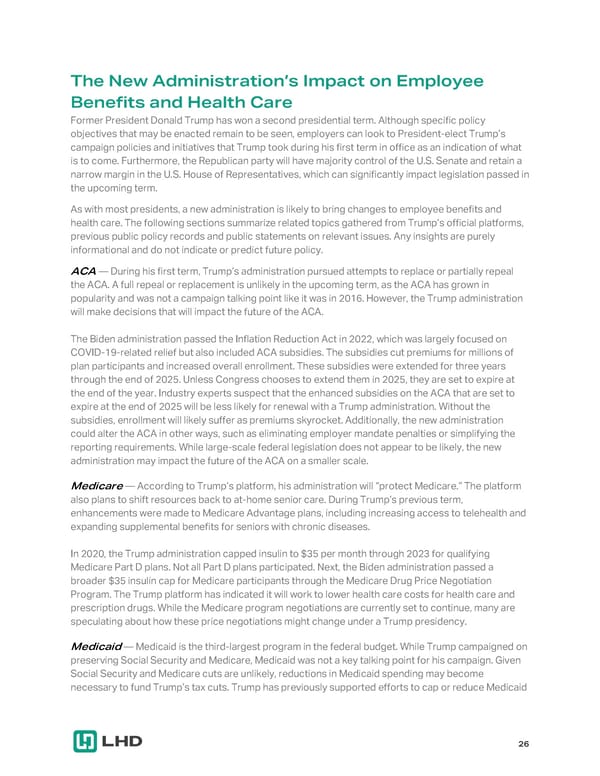The New Administration’s Impact on Employee Benefits and Health Care Former President Donald Trump has won a second presidential term. Although specific policy objectives that may be enacted remain to be seen, employers can look to President-elect Trump’s campaign policies and initiatives that Trump took during his first term in office as an indication of what is to come. Furthermore, the Republican party will have majority control of the U.S. Senate and retain a narrow margin in the U.S. House of Representatives, which can significantly impact legislation passed in the upcoming term. As with most presidents, a new administration is likely to bring changes to employee benefits and health care. The following sections summarize related topics gathered from Trump’s official platforms, previous public policy records and public statements on relevant issues. Any insights are purely informational and do not indicate or predict future policy. ACA — During his first term, Trump’s administration pursued attempts to replace or partially repeal the ACA. A full repeal or replacement is unlikely in the upcoming term, as the ACA has grown in popularity and was not a campaign talking point like it was in 2016. However, the Trump administration will make decisions that will impact the future of the ACA. The Biden administration passed the Inflation Reduction Act in 2022, which was largely focused on COVID-19-related relief but also included ACA subsidies. The subsidies cut premiums for millions of plan participants and increased overall enrollment. These subsidies were extended for three years through the end of 2025. Unless Congress chooses to extend them in 2025, they are set to expire at the end of the year. Industry experts suspect that the enhanced subsidies on the ACA that are set to expire at the end of 2025 will be less likely for renewal with a Trump administration. Without the subsidies, enrollment will likely suffer as premiums skyrocket. Additionally, the new administration could alter the ACA in other ways, such as eliminating employer mandate penalties or simplifying the reporting requirements. While large-scale federal legislation does not appear to be likely, the new administration may impact the future of the ACA on a smaller scale. Medicare — According to Trump’s platform, his administration will “protect Medicare.” The platform also plans to shift resources back to at-home senior care. During Trump’s previous term, enhancements were made to Medicare Advantage plans, including increasing access to telehealth and expanding supplemental benefits for seniors with chronic diseases. In 2020, the Trump administration capped insulin to $35 per month through 2023 for qualifying Medicare Part D plans. Not all Part D plans participated. Next, the Biden administration passed a broader $35 insulin cap for Medicare participants through the Medicare Drug Price Negotiation Program. The Trump platform has indicated it will work to lower health care costs for health care and prescription drugs. While the Medicare program negotiations are currently set to continue, many are speculating about how these price negotiations might change under a Trump presidency. Medicaid — Medicaid is the third-largest program in the federal budget. While Trump campaigned on preserving Social Security and Medicare, Medicaid was not a key talking point for his campaign. Given Social Security and Medicare cuts are unlikely, reductions in Medicaid spending may become necessary to fund Trump’s tax cuts. Trump has previously supported efforts to cap or reduce Medicaid 26
 2025 Employee Benefits Market Outlook Page 25 Page 27
2025 Employee Benefits Market Outlook Page 25 Page 27